
Crush, Crumble and Chomp! (subtitled The Movie Monster Game) has been on my radar since day 1 of this blog, but I was not quite sure what to do about it because rampaging cities with giant monsters is not the typical scope of “wargaming”. Still, it was a unique game that I felt was missing from my portfolio, so I put it on my back burner to eventually play between two hardcore wargames, and well – the time has arrived. As I was writing this article, I was vindicated in a way I did not expect: Crush, Crumble and Chomp! is the direct descendant of a game with impeccable wargaming pedigree: Ogre, “the classic game of future tank warfare“, but more on this latter.
The DataDrivenGamer already covered Crush, Crumble and Chomp!, and I am happy to come after him because it gives me a clear objective: beat his score with the first two monsters: the gigantic robot Mechismo (1987 points, personal bonus objective: destroy the IRS building) and the Kraken (3063, personal bonus objective: destroy the Golden Gate)!
A. The Day The Giant Robot Torched The IRS

The year was 1953, and the air in Washington, D.C., was thick with the summer heat. John Mannfried, a tech genius of unparalleled skill, had finally reached his breaking point. Earlier that day, he had received a letter from the Internal Revenue Service (IRS). The letter was filled with dreadful bureaucratic language, but the only words Mannfried could see were “Comprehensive Audit”.
To Mannfried, this was an affront. He was a visionary, and his 80,000 hours were far too important to be bogged down by the tedious demands of tax documentation. His inventions had brought him a few modest billions, which he dutifully poured back into his work – so really, it was all investment, top of the P&L, deductible, not taxable. The IRS, however, saw things differently.
The audit process began with a summon to the IRS office, to which Mannfried sharply replied that he would attend, though he did not specify “personally.” In the shadows of his secret lab in downtown Washington, he had built his masterpiece: Mechismo. Now, he would give the giant robot a purpose – to obliterate the IRS.
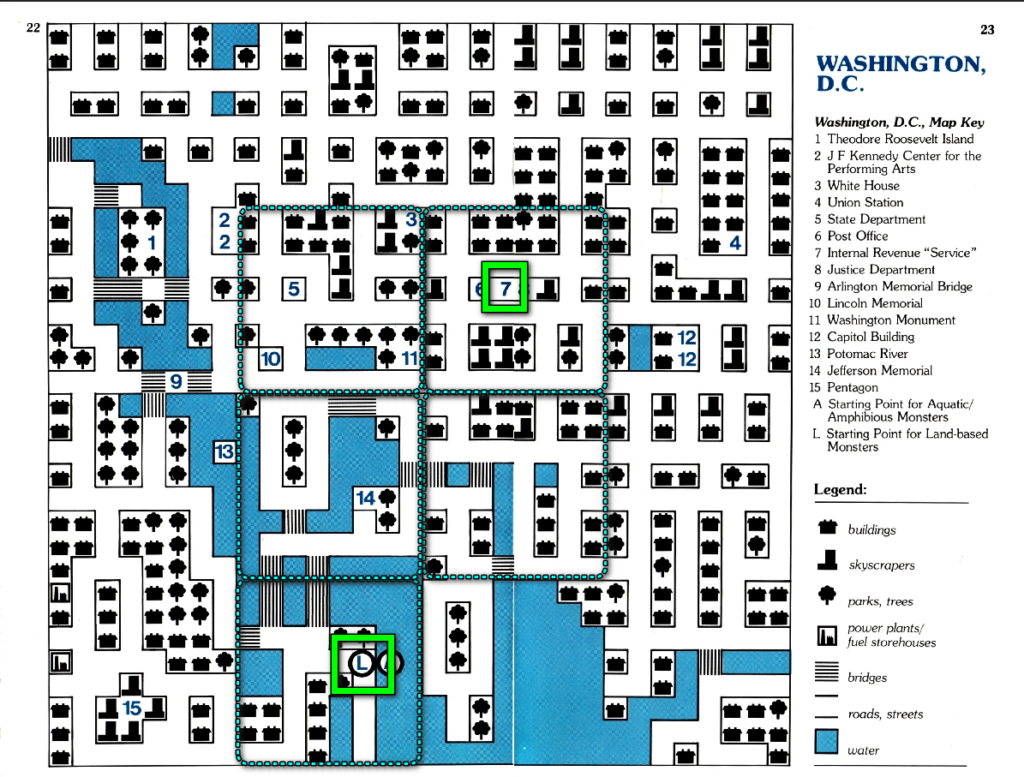
Standing twenty feet tall, the robot was equipped with disintegration rays capable of targeting both ground and air units, and flamethrowers mounted in its head, which it could tilt left or right to incinerate everything in its path. As dawn broke over the capital, Mannfried activated Mechismo, sending it lumbering towards its target from a launch point just south of the Washington Monument, across the Potomac.

The robot’s footsteps echoed through the air, causing onlookers to gape in terror. The authorities however were quick to respond. Sirens wailed as a fleet of police cars sped to intercept the metallic behemoth. But Mechismo’s advance was relentless, and it stomped on the police cars like they were toys.
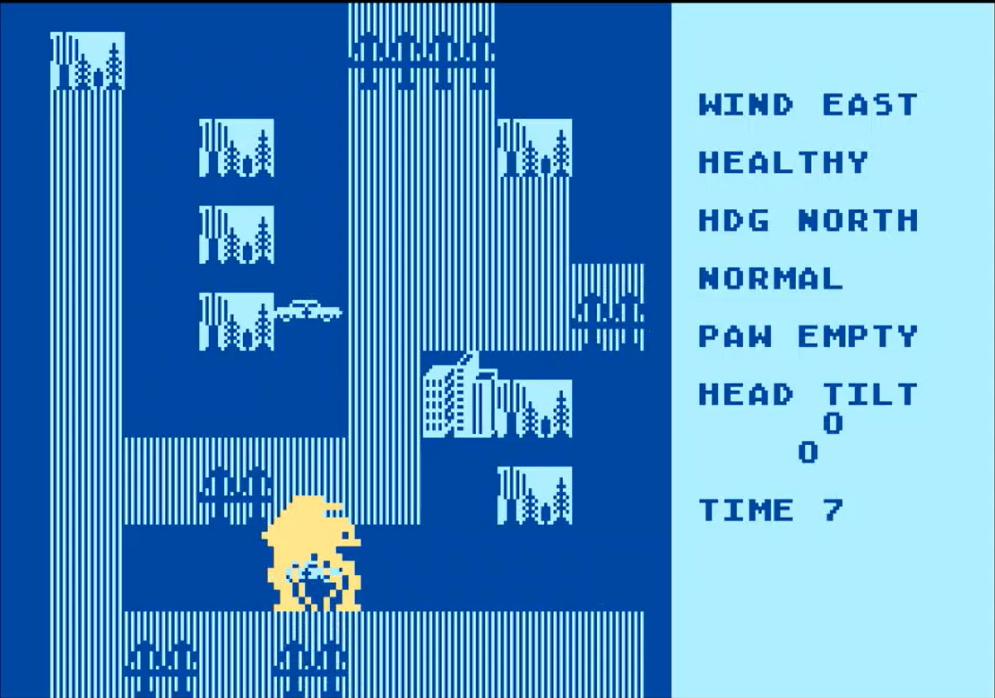
Turning east, Mechismo encountered an unexpected menace: not one, but two mad scientists patrolling the air in their white choppers.
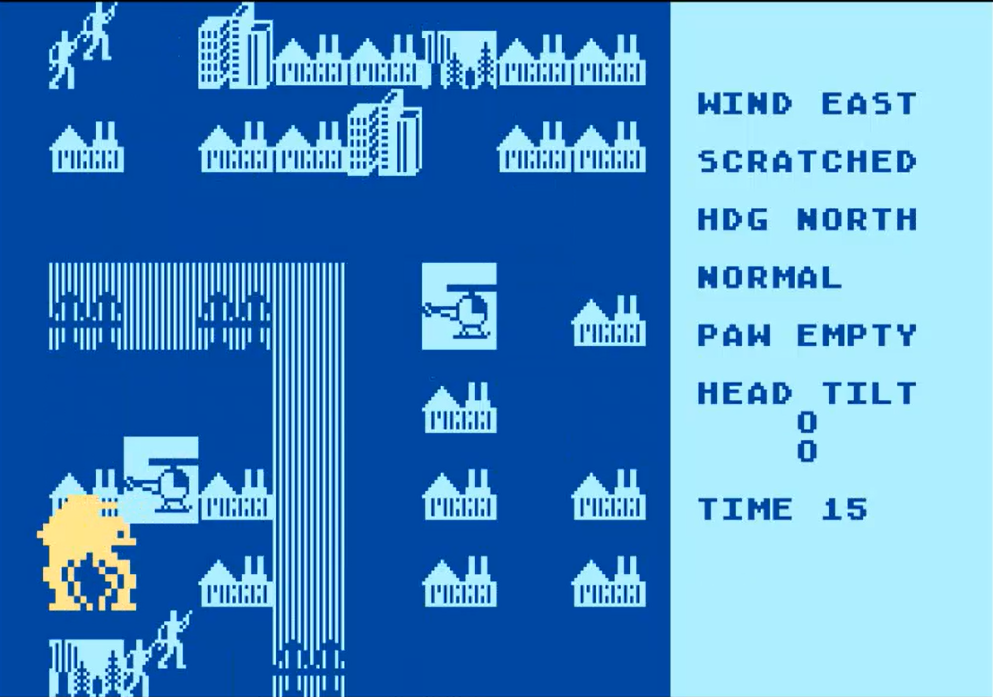
Enemies don’t follow you across quadrants and are reset when you get in a new one, so moving West then East solved the problem.
For a moment, the hunter could have become the hunted. Thankfully, the security forces in Washington operate under the yoke of “standard operating procedures”, and none dared to leave their quadrants. Moving west and then returning was enough to trick the mad scientists, and the streets were deprived of their flying guardians. With ruthless efficiency, Mechismo torched targets of opportunity, setting buildings and vehicles ablaze as it continued its march.
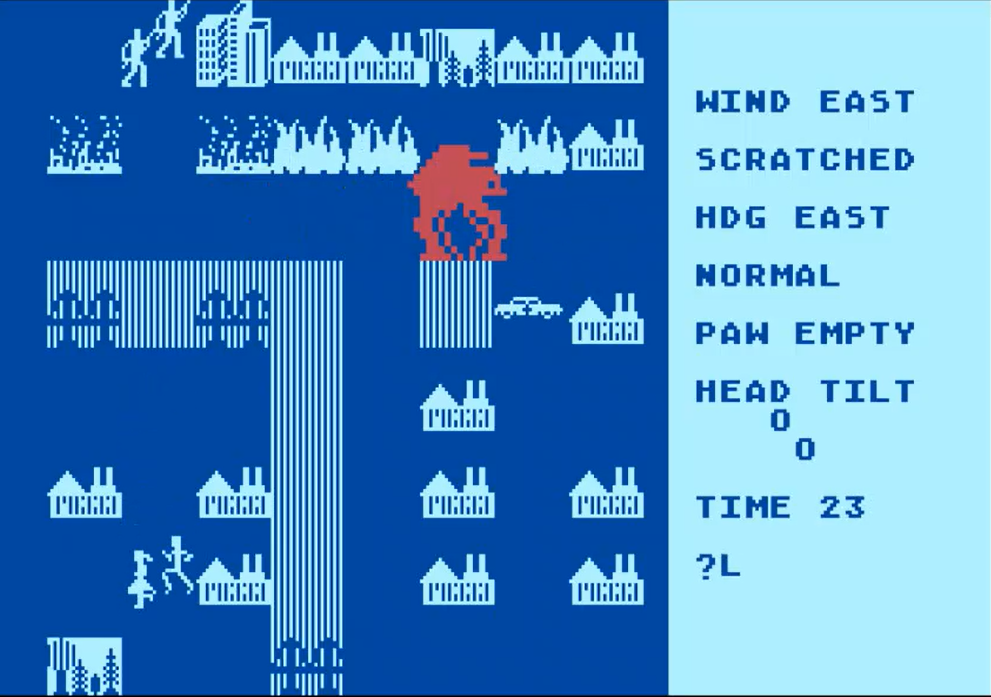
The National Guard was called in, deploying soldiers and armored units in a desperate bid to halt the mechanical menace. Mechismo’s disintegration rays hummed to life, slicing through men and tanks, vaporizing helicopters in mid-air. The robot’s flamethrowers belched fire, engulfing buildings and vehicles alike in searing flames. It was a scene of utter chaos and destruction.
As Mechismo approached the IRS building, it tilted its head to the side and unleashed a torrent of fire. The IRS, the Justice Department, and the Postal Office were engulfed in an inferno. Mannfried watched from a distance, a twisted smile of satisfaction on his lips.
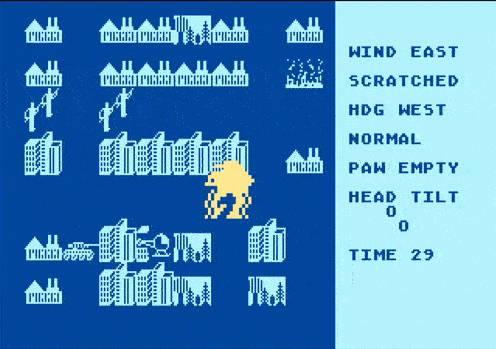
The commands HL/HR turn my head to the left/right – much faster than turning the whole body.
Its primary objective achieved, Mechismo aimed to inflict as much damage as possible on the taxpayers who had, by their submissiveness, allowed this accursed institution to exist. Holding its position north of the Washington Monument, the giant machine fought against the National Guard’s tanks, artillery, and helicopters. It was a proud fight, but slowly, surely, the robot’s armour weakened. The combined firepower of the National Guard finally overwhelmed the mechanical giant, and with a final, thunderous crash, Mechismo collapsed, a smoking ruin of twisted metal.
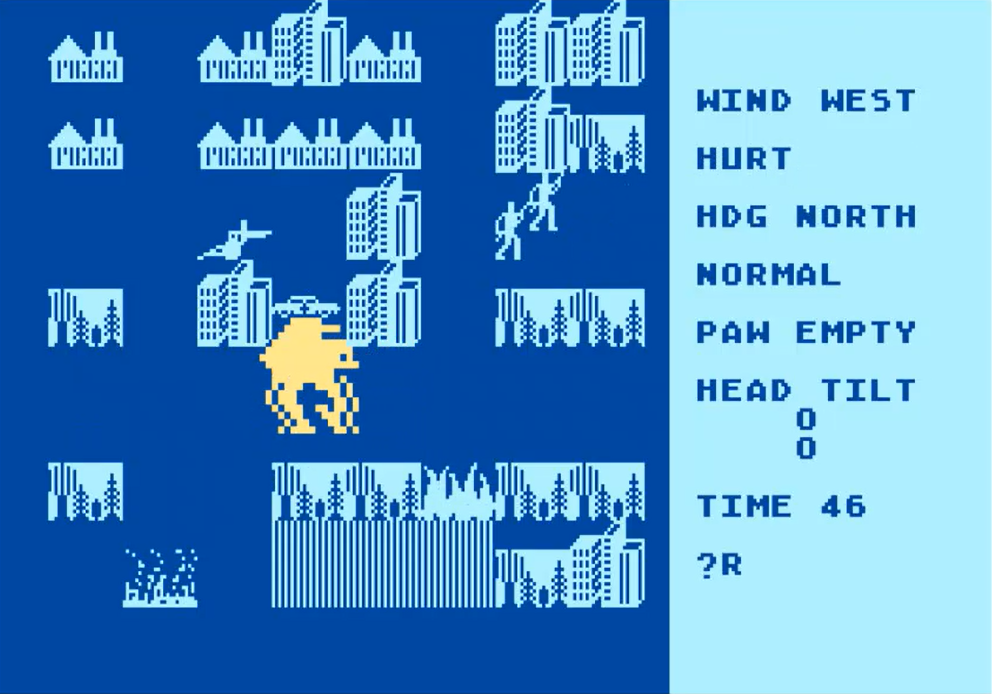
As sad as Mannfried was to see his creature falter, he knew he had taught the government a lesson. The comprehensive audit would have to be postponed sine die. Satisfied, he returned to his blueprints…
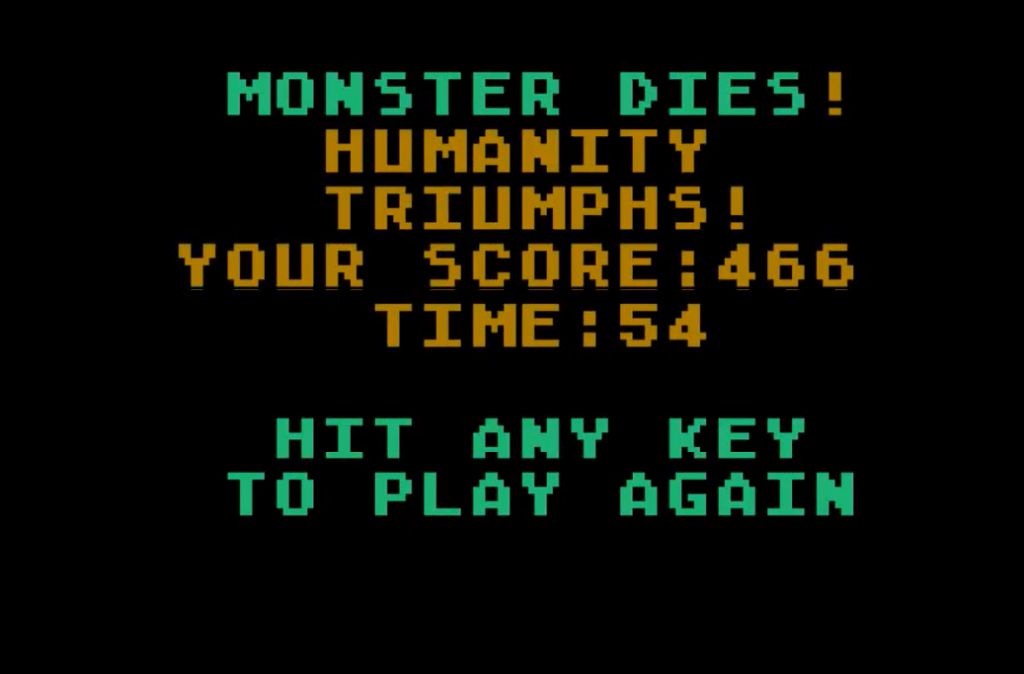
B. The Monster That Ate A Bridge
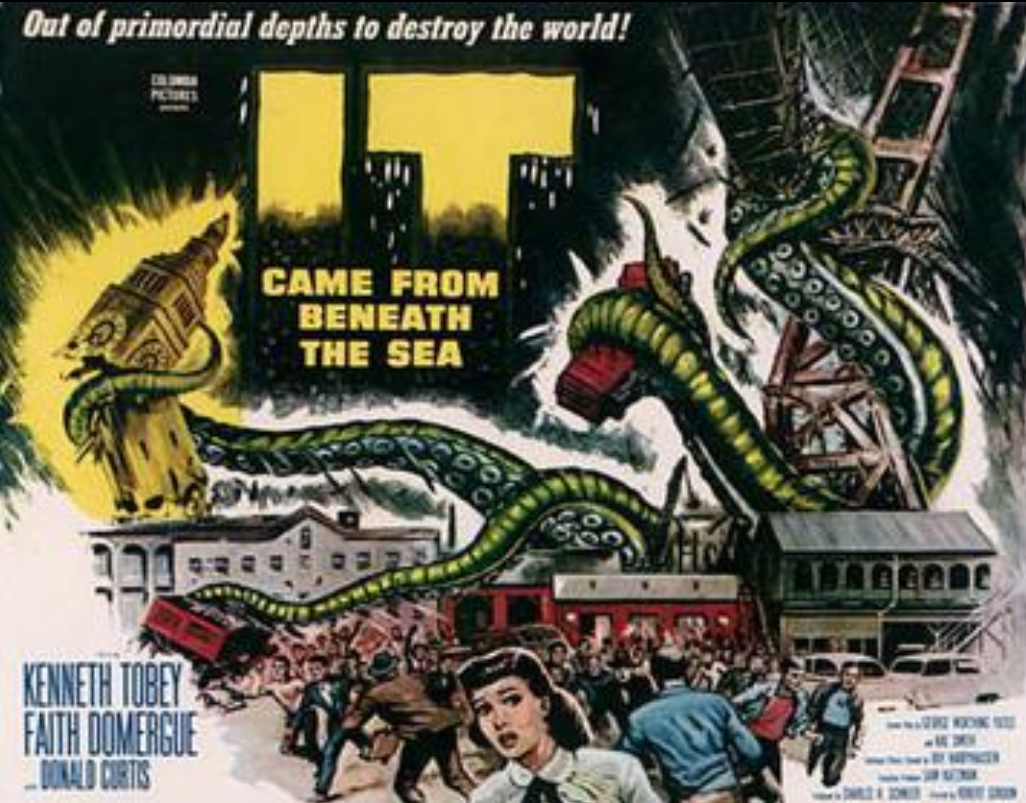
Deep beneath the waters of the California Bay, Kraken laid dormant. She had slumbered for centuries, undisturbed and forgotten. But human activity had ever so slowly stirred her from her deep sleep. As she emerged to see what had happened, her ire was piqued. Some metal monstrosity was closing her bay. She knew the humans from the last time she had freely roamed the sea, with their curious wooden devices which wandered haphazardly over great distances over water, but this time they had gone too far! This bridge was a barrier, a cage that sought to confine her to the Bay!
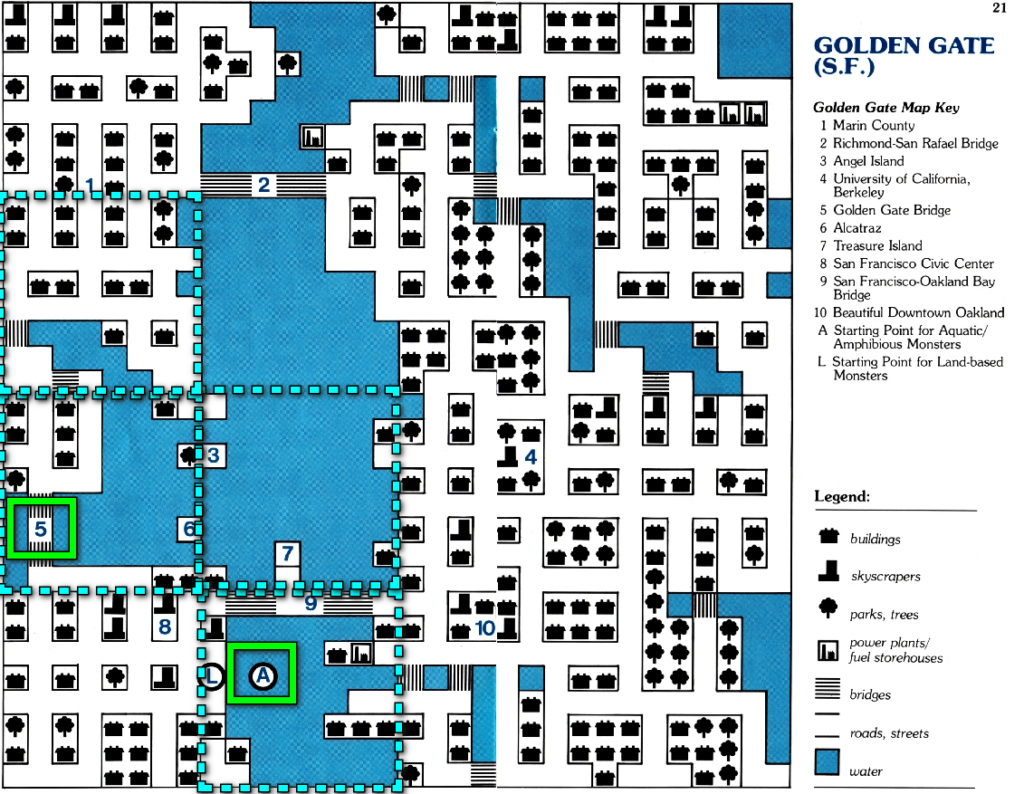
Kraken surged forward. She reached the shoreline, her powerful limbs crushing buildings along the riverside with ease. As for the building out of range of her tentacle, she used her atomizing ray.
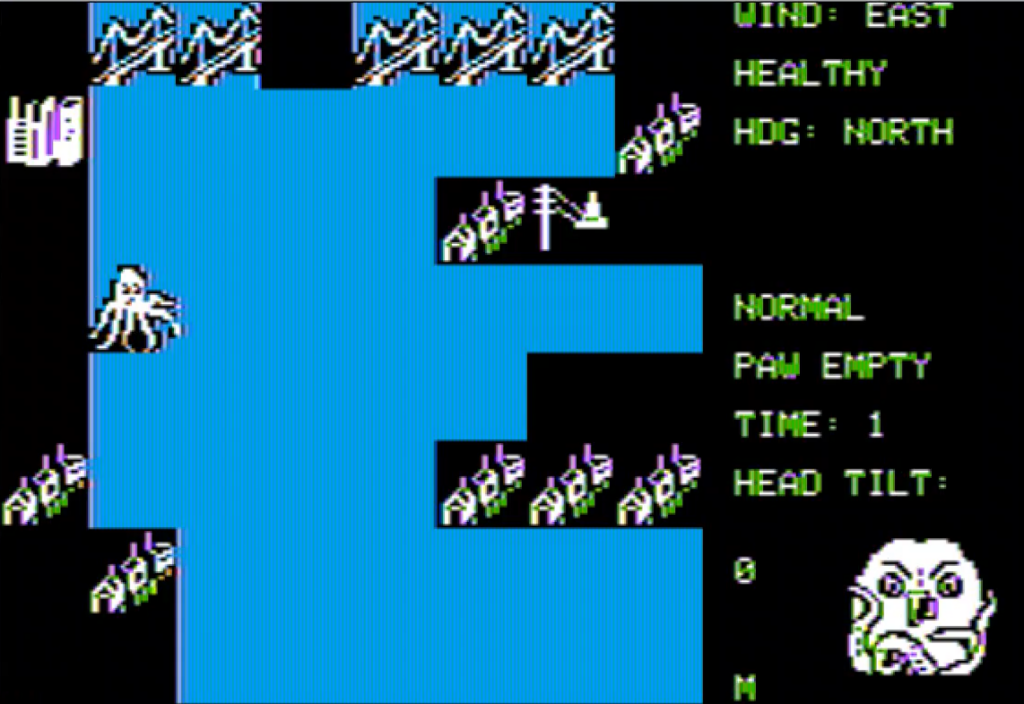
As she moved north, her destruction was relentless, and lacking boats, there was nothing the humans could do. Unlike an earlier robotic monster which had made the news, Kraken’s atomizing ray couldn’t hit airborne targets. She had to rely on her tentacles to grab and devour them. Eating was crucial; if she starved, she would become berserk and lose control of herself.
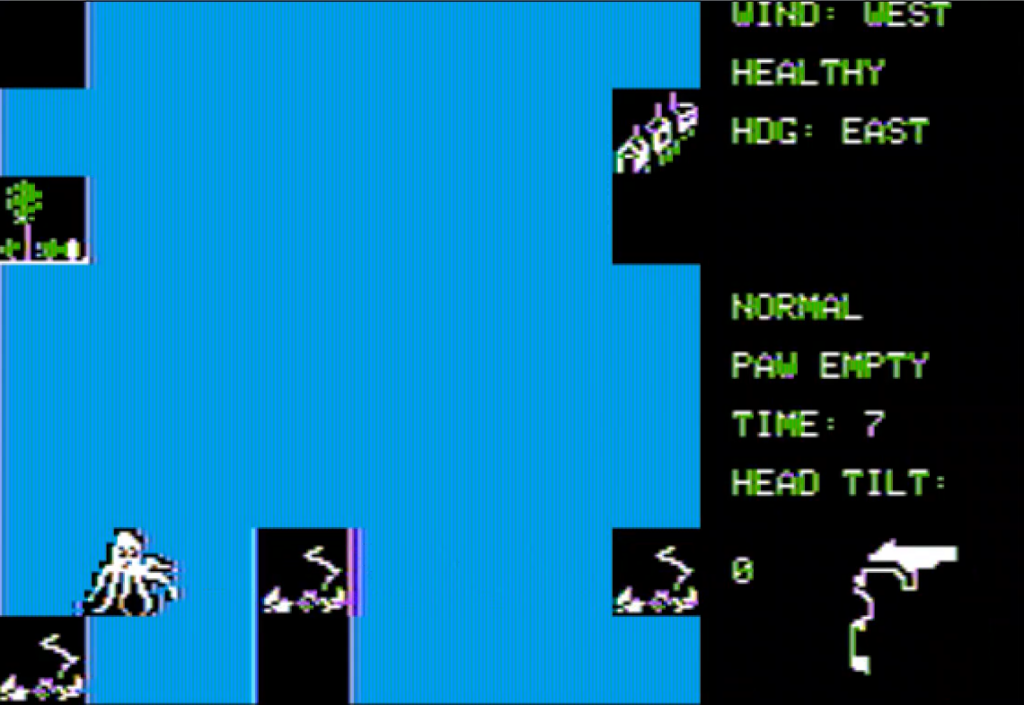
Finally, she reached the Golden Gate Bridge:
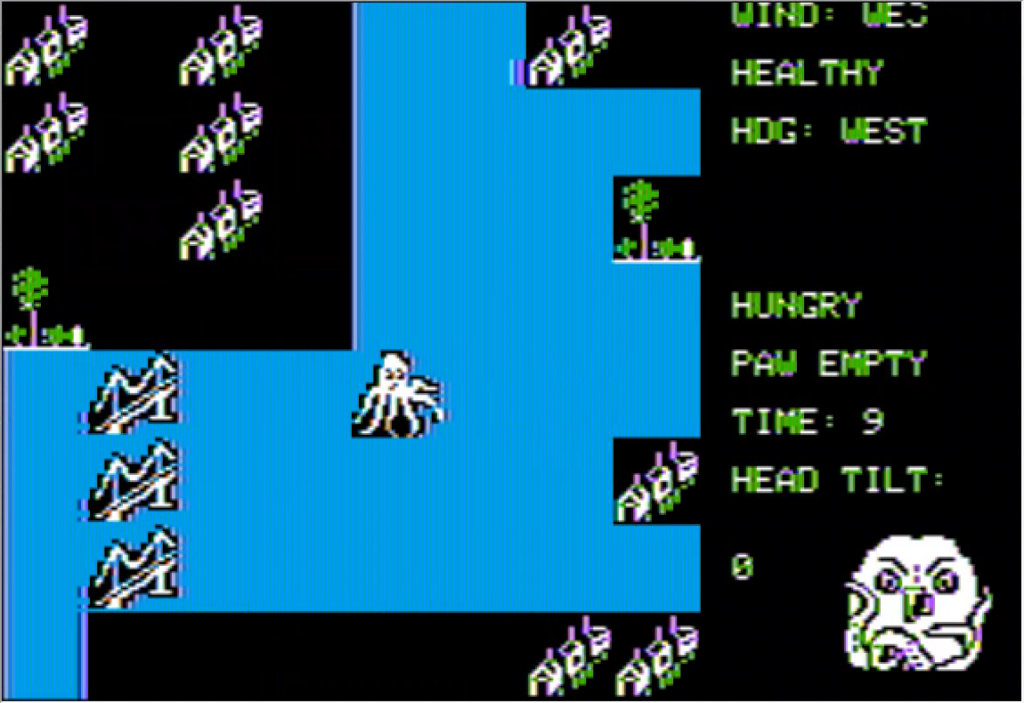
She wrapped her tentacles around the massive structure. Steel groaned under her immense power. Finally, the bridge’s supports snapped like twigs.

Satisfied with her work, Kraken turned her sights northward and entered Richardson Bay. But as she moved, she was suddenly beset from all sides. The National Guard had mobilized, surrounding her with tanks, artillery, and more helicopters.
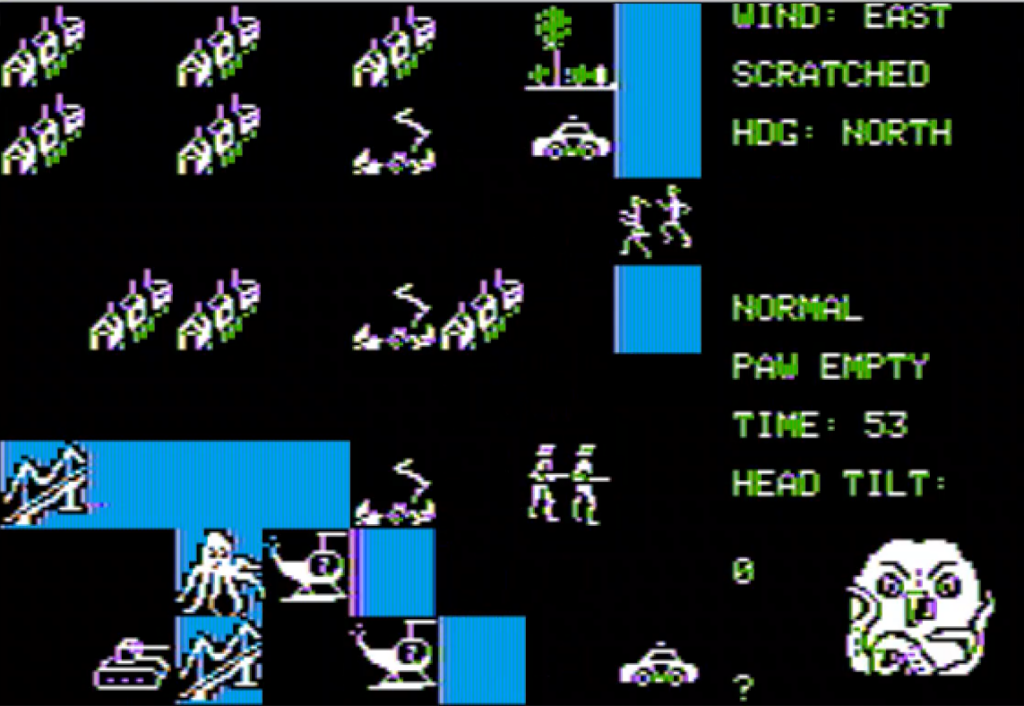
While most attacks ricocheted off her tough hide, Kraken realized she had little room to avoid her enemies. After unleashing devastation with her atomizing rays, she retreated back to the more open water of the Golden Gate.
Alas, the humans were waiting for her. Wounding her at distance with their tanks, she had to dive and travel underwater to retreat further East.
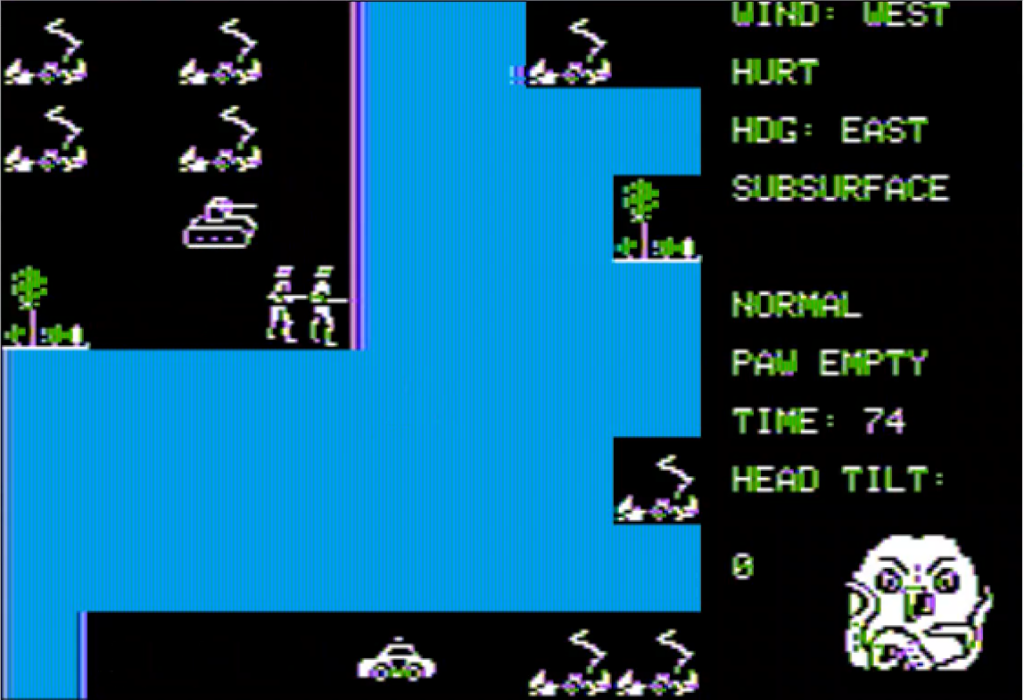
The dance between the monster of the Sea and the machines of the Earth continued for a while. Kraken would heal, snatch maybe a human or a car to fend off hunger, and then return to the Golden Gate.
This eventually came to an end, when the Mad Scientist hit Kraken with his paralysing ray.
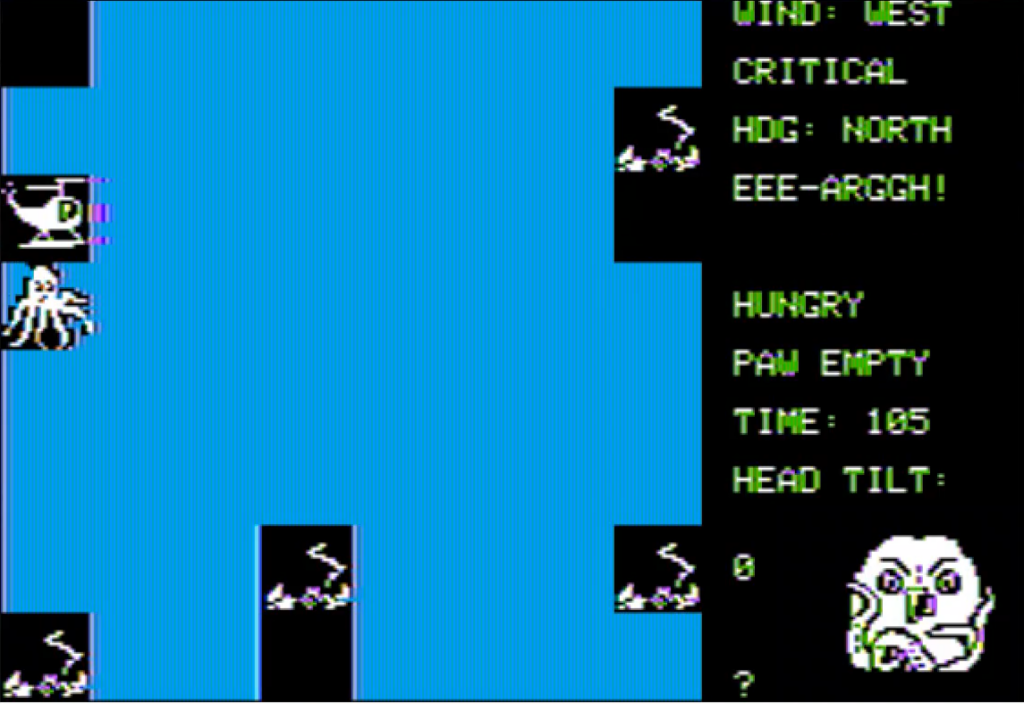
The effect was not immediate, but for Kraken each movement was slower than the previous one. The monster from the depth could not both feed herself and avoid the artillery the humans had installed on the shore.
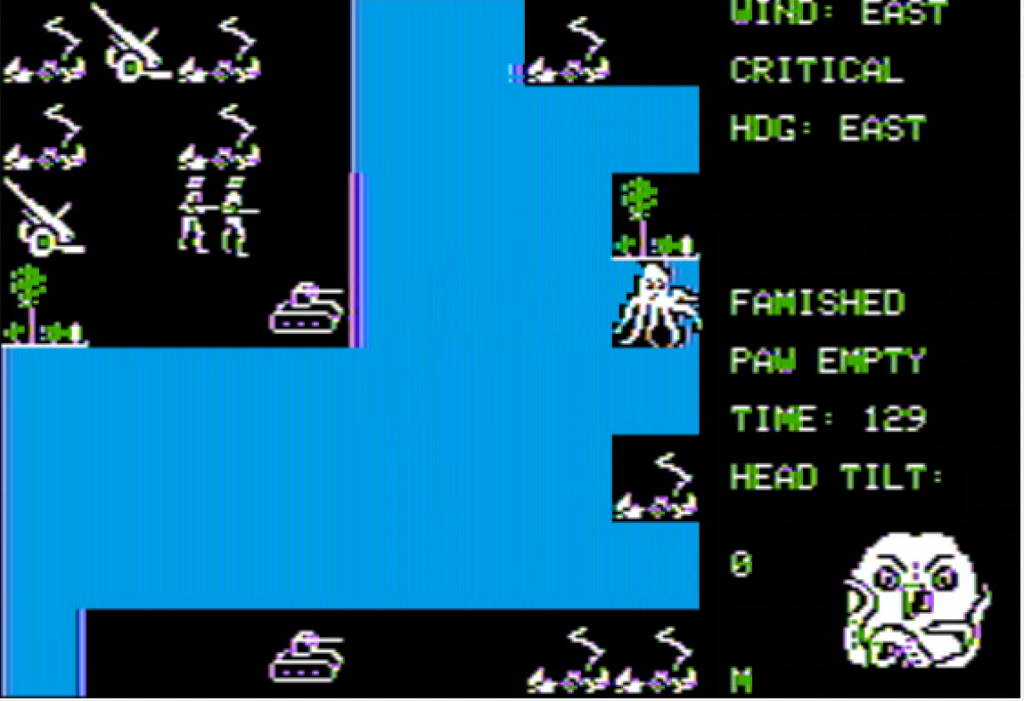
Eventually, the monster took one last, final dive. She would not return. Humanity had triumphed.
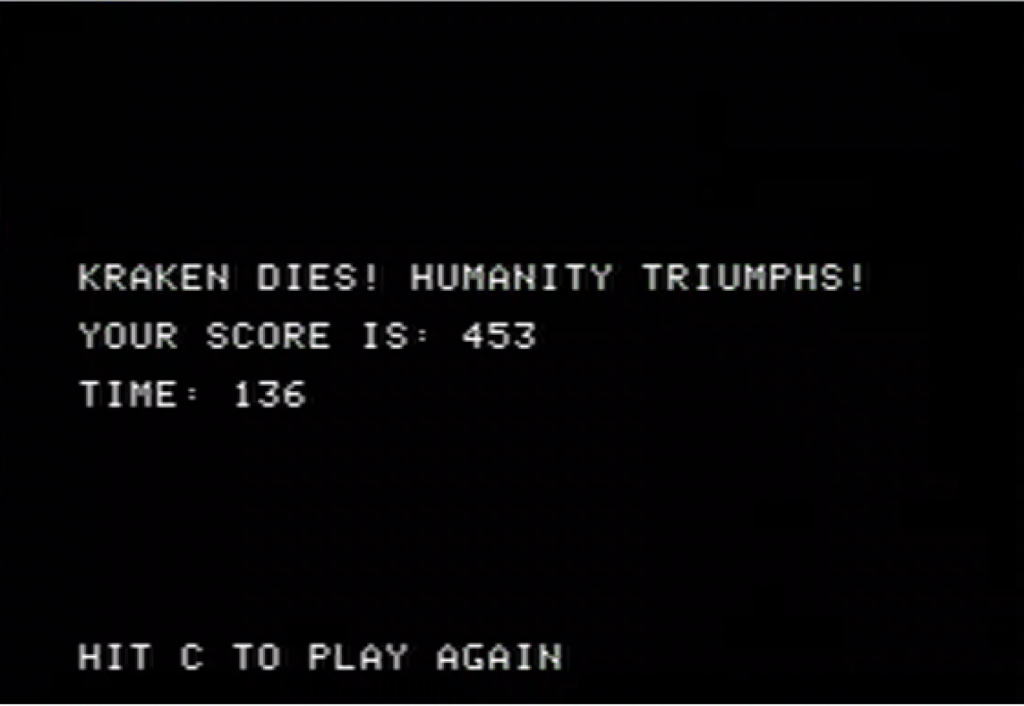
Ratings and Reviews
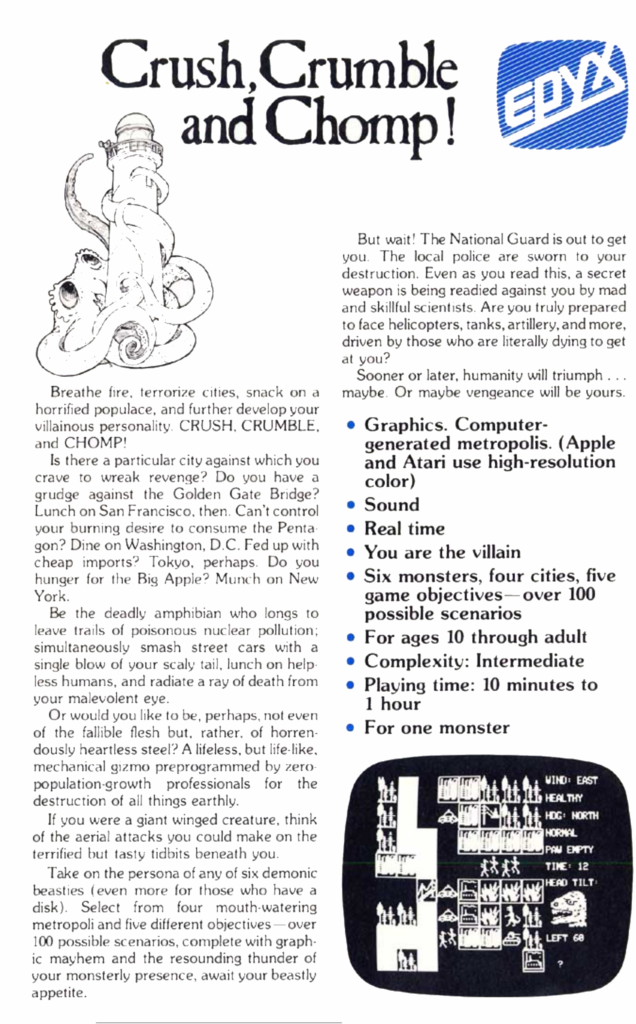
Crush, Crumble and Chomp! by Jon Freeman, published by Automated Simulations, USA
First release: May 1981 on TRS-80
Genre: Single Unit Tactics
Average duration of a session : 10-20 minutes
Total time played: 3 hours
Complexity: Medium (2/5)
Rating: One star
Ranking at the time of review: 37/139
Context – We know Automated Simulations, co-founded in 1978 by designer Jon Freeman and coder Jim Connelley, since the beginning of this blog with Invasion Orion. After Invasion Orion, Automated Simulations released the Temple of Apshai, which the cRPGAddict describes as “first true commercial RPG“. The Temple of Apshai was wildly successful, and its BASIC engine was modified, recycled and tortured beyond recognition to make sequels to Temple of Apshai (the DunjonQuest series), but also a sci-fi spin-off series (StarQuest) – the engine being used to make both full-fledged turn-based RPGs and time-based action games. Connely liked the engine, as it was flexible and universal – the games could be easily adapted to any platform – but for Freeman the engine was pulling the company back and limiting his creative freedom. As Connely would not move, Freeman presumably tried to find a balance between what the engine could do and what he wanted to do, and landed on adapting SPI’s The Creature That Ate Sheboygan.
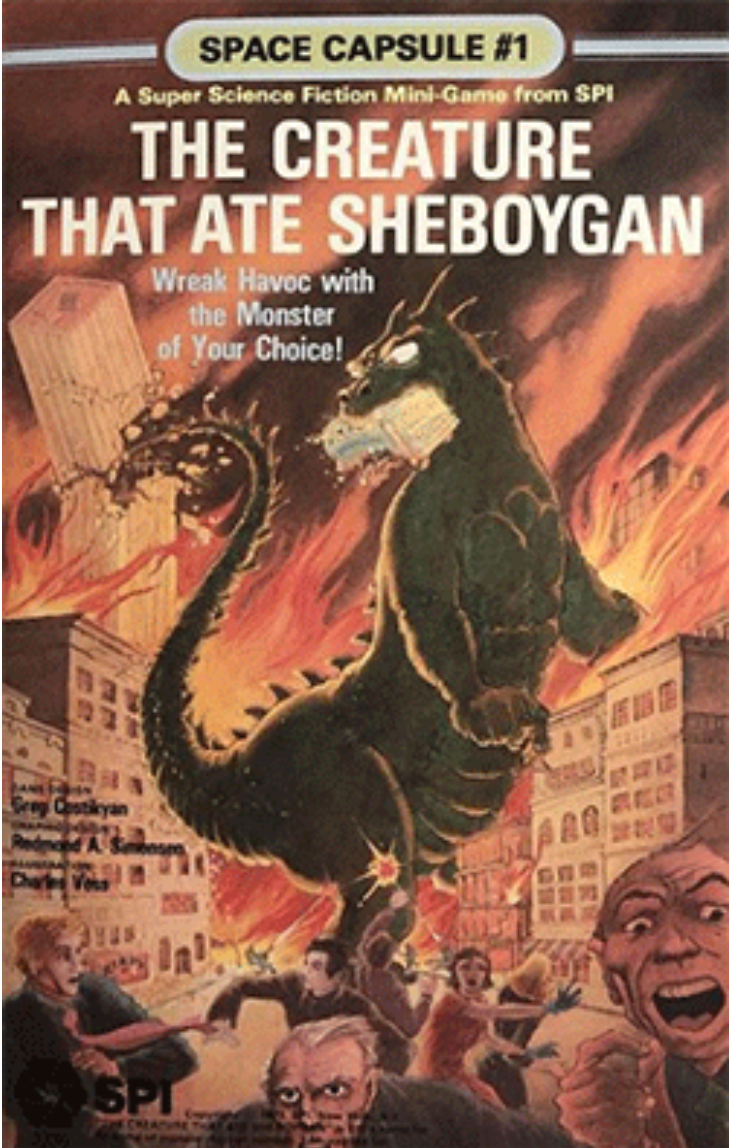
In the later part of the 70s, SPI’s financial situation was increasingly difficult, the consequence of a combination of narrow margins and awful stock management. Instead of finding a solution inwards, SPI hoped to find a magic bullet by copying its competitors. The rising star of boardgaming in that era was Metagaming Concepts, whose “Microgames” had taken the market by storm, starting with Ogre en 1977. Trying to replicate this success, SPI launched a new “Capsule” format for only $3.95. Some of the Capsule games would be cheap re-print of classical SPI games, but of course the format was all about volume, which meant new games, and more specifically Science Fiction or Fantasy games, which as SPI had recently discovered sold miles better than wargames. The first game of the Capsule series, released in March 1979, was Greg Costikyan’s The Creature That Ate Sheboygan.
It is hard not to see the Ogre in The Creature That Ate Sheboygan. Of course, the gist of the game – one player managing a powerful creature, the other a host of smaller ones – is the same. But the rules are damning, in particular the way attacks are resolved (different attackers can group their attacks, and the monster can split its attack). In any case, while the design was not new anymore, the monster-vs-city theme was strong (I reckon it is stronger than the super-tank theme), and the game was a success – a success which, as the story goes anyway, only worsened the financial situation of SPI as the Capsule games were reputedly sold at a loss.
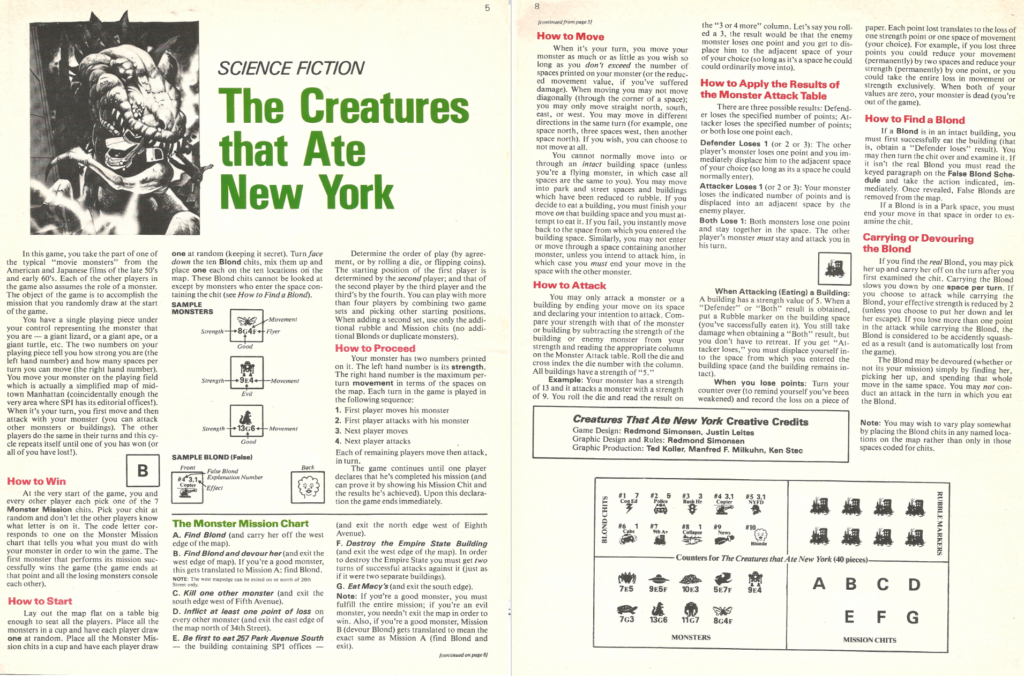
Freeman was well aware of The Creature That Ate Sheboygan, as he covered it at length in his 1980 Complete Book of Wargames. He rated the game “Very good“, commenting: “It really is as much fun as it appears, particularly if your monster is equipped with fire-breathing“. It was however not a lazy adaptation. Freeman kept the fun parts (the design of the monster, the fire spreading), adapted the controls to the weird “real-time with action points” system of the DunjonQuest engine and added two key features missing in the original: the hunger gauge and its head tilting – two features that add a lot of depth to the game. He also largely expanded the options for the monster, including among others nautical monsters that the boardgame missed.
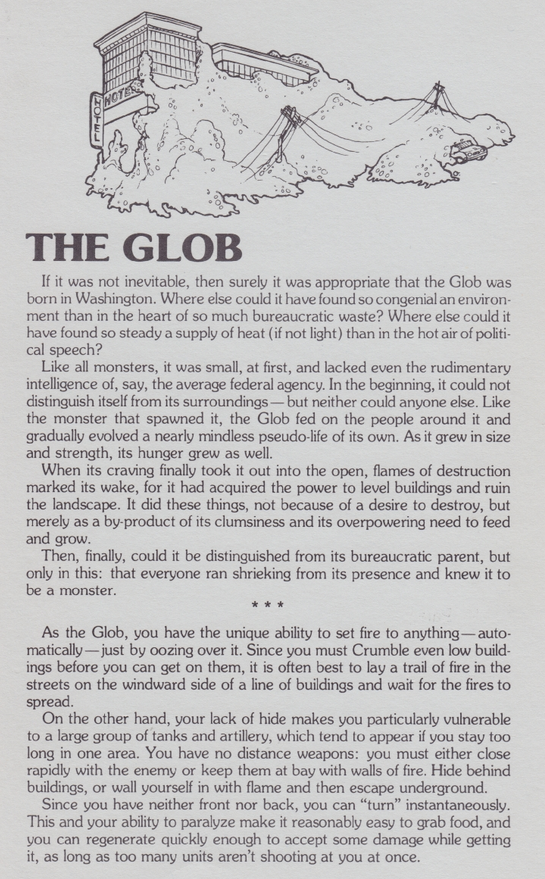
As was usual for Automated Simulations, Crush, Crumble and Chomp! was first released for TRS-80. (the first mention of the game I found was in the May 1981 issue of Analog Computing); over time the game would be ported on most computers of the era: Atari, VIC-20, Apple II, later DOS and Commodore 64 – however Freeman would not be involved in the later versions.
In the last chapter of his book, Freeman forebode “At the moment, Automated Simulations has a near monopoly on sophisticated role-playing and wargames for microcomputers. This can’t last.” While he did not anticipate where the competition would come from (he expected Avalon Hill, SPI and Metagaming Concepts to take the lead in computer gaming), he anticipated that games only had a fragment of the complexity they would have in five or ten years. With Connely unwilling to modernize the engine, Freeman felt Automated Simulations was heading toward a dead end, and as we know he left the company in early 1982 to found Freefall Associates with designer Paul Reiche III and developer Anne Westfall.
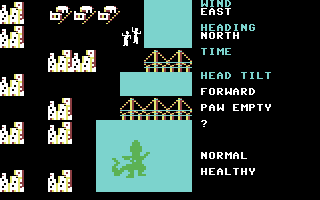
Traits – Crush, Crumble and Chomp! is a game that would have been outstanding if it had been made in 1982 or 1983, with a fresh engine that would have integrated the collective insights of two more years of video game UX design. Alas, it carries instead all the idiosyncrasies of a 1978 engine and all the limitations of a TRS-80 game. The most obvious is the lack of choice between turn-based and action point-based, and the game manages to combine the worst of both worlds: the player has very little time to decide among 10+ commands, but at the same time if they type two orders back-to-back the second movement can be interrupted by an enemy turn and become obsolete – but executed nonetheless.
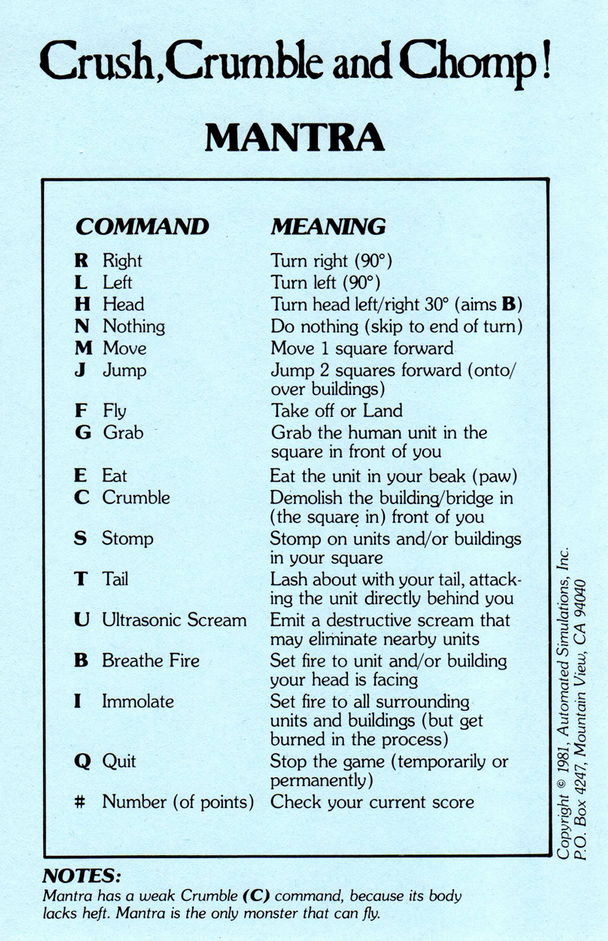
As was typical of 1981, the map is divided into “screens” instead of a smooth scroll, which makes all the cities look the same and – this is probably the worst flaw of the game – kills most of the strategic and tactical depth of the game: unit placements are reset every time you change screen, so the best way to score points is to hug the borders of a screen (or camp in a corner) and leave it when things are becoming too heated – it works until the Mad Scientist spawns next to you anyway.
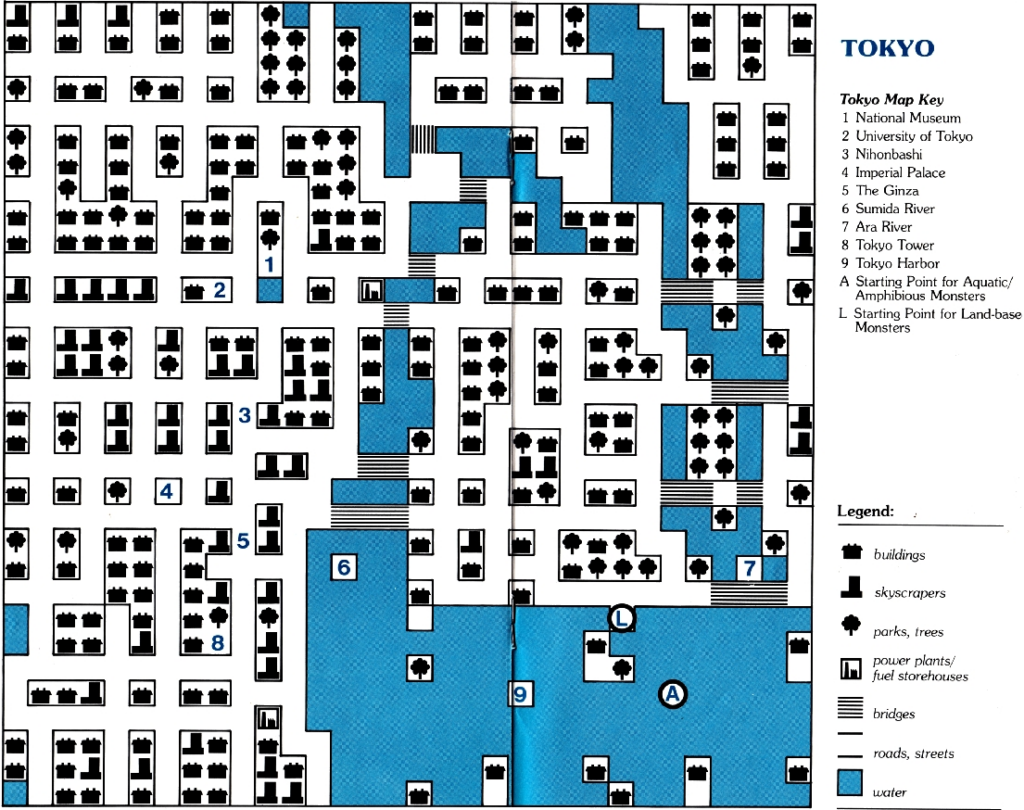
There are still a lot of nice features in the game, in particular how diverse the cast is and the number of options for those versions with a “monster-creator”. The different monsters play differently, and I had some fun trying to create the “perfect monster” and give myself personal objectives based on the map, even though I did not care much about the points – except in those two games where I tried and utterly failed to beat the DataDrivenGamer’s score.
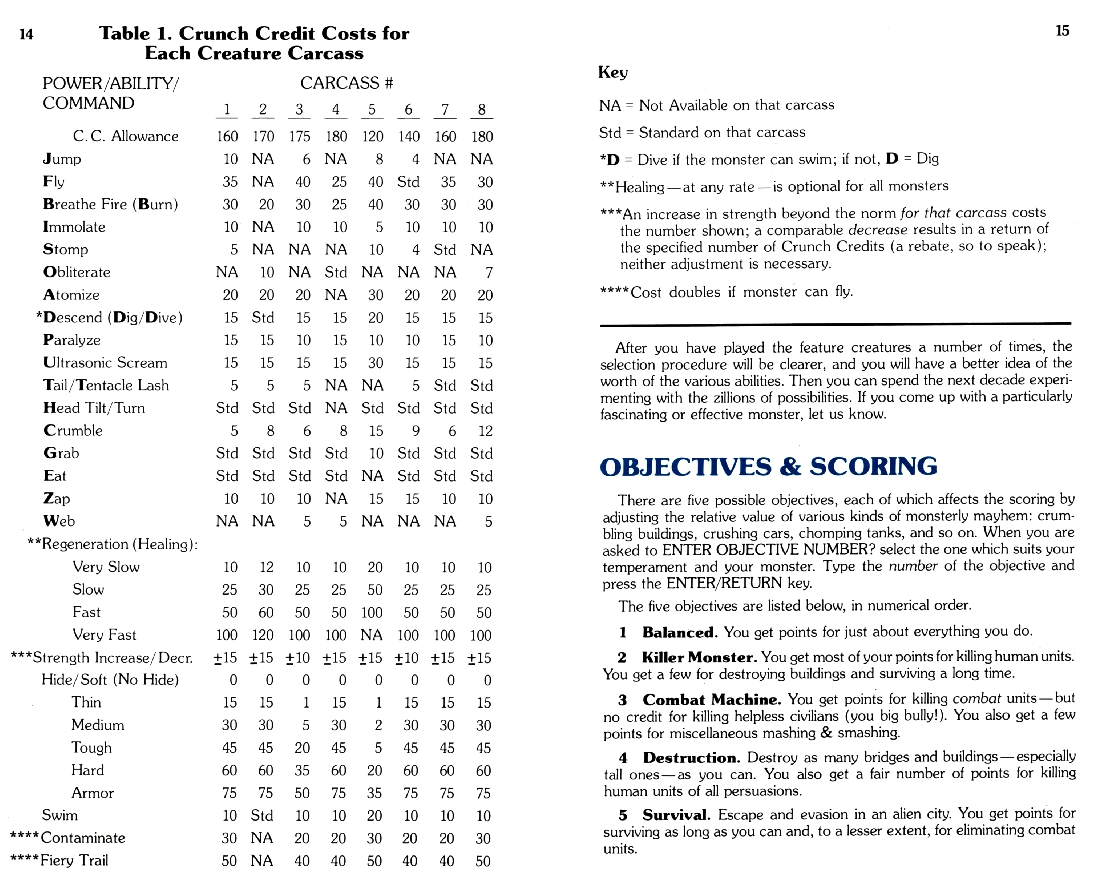
Did I make interesting decisions? Yes, though tactical only. Some were ruined by erroneous inputs caused by the terrible UI.
Final rating: One star. Crush, Crumble and Chomp! is slow, clunky and frustrating to play, but still it aged better than it should have thanks to its great customization options and by virtue of still being almost alone in its niche more than 40 years later, at least outside of Japan. If the enemies had not been reset every time you change screen, it could have even earned a second and possibly a third star!
Reception
With a strong theme and all the relevant platforms supported, Crush, Crumble and Chomp! received so many reviews it would be pointless to list them all. They all go in the same direction anyway: the game is “a classic” (Creative Computing, December 1981), “ahead of the other games I have tried” (80 Microcomputing, February 1982), “A for originality and laughs” (Analog Computing May 1982) and, er, “Playtesters of all ages respond well to this game” (Family Computing, November 1983). As a matter of prestige, Crush, Crumble and Chomp! was one of the few games with a full review/article in the first issue of Computer Gaming World in November 1981, whereas Eastern Front 1941 only received a “micro-review” in the same issue.
The reviews generally emphasize the freedom offered by the game (in particular with the monster creator) and how cathartic crushing, crumbling and torching real places can be, with for instance Computer Gaming World quipping “The fact that the game is set in actual cities and most of us are familiar with at least one of them makes the game more interesting than if the game were set in an abstract city or some lesser known city like Sheboygan.” When they complain, the reviewers lambast the slowness of the game, particularly on TRS-80.
Crush, Crumble and Chomp! proved quite durable too. The release of IBM PC and Commodore 64 ports and its accompanying international release saw a new batch of reviews in 1983-1984, and the reviews were still fairly good, though several tones lower than in 1981-1982: the art and the UX is by then way below standards, despite the effort of whoever worked on the Commodore 64 version. Automated Simulations, renamed Epyx, decided to modernize the game, and in 1986 released the spiritual sequel The Movie Monster Game that should eventually reach this blog.